How to Make Money at Google AdWords: Predicting ROI
by Aden Andrus • November 28, 2017
Return on investment (ROI) is the holy grail of pay-per-click (PPC) metrics and is the only real way to know if your online marketing investment is paying off. Unfortunately, it’s also notoriously difficult to track.
It’s definitely worth it to go to that effort, but according to CMO 79% of companies haven’t reached this level of tracking yet.
So the question is, if you don’t have ROI tracking set up yet, which other metrics are the best indicators that you’re probably making money?
This article is all about answering that question.
At Disruptive Advertising, ROI tracking is our bread and butter, so we decided to put that expertise to work for you. We studied years of AdWords data taken from over 50 ecommerce businesses bidding on over half a million keywords. We compared each Keyword’s return on investment with dozens of other variables in order to identify the very best predictors of success.
Here’s what we learned:
Study Sample
Before I dive into our findings, I’m going to take a quick minute to talk about the data set we used in our study. In this study, we compiled data from the all-time keyword performance reports of 58 eCommerce businesses. Together, this data represented 13 distinct sub-industries, 6,690 campaigns, and 528,127 keywords.
We chose to focus on eCommerce first because eCommerce is the most straightforward example of online money-making. With many other businesses, the goal is to get leads, email subscriptions, chats, phone calls…the list goes on and on. But with eCommerce businesses, conversions are almost always sales.
Now, you might be thinking, don’t eCommerce companies run Google Shopping campaigns, not text ad campaigns? How this data applicable to my text ads? How did you even get keyword data?
Those are good questions. Because eCommerce companies have the best direct ROI data, we decided to use them as our data source. However, to ensure that our results were fairly generalizable, we only pulled keyword data from companies that were running text ads to drive sales. That way, we got the best of both worlds: high-quality ROI data on text ad keyword performance.
Thinning the Herd
No sooner had we pulled our data together than it became obvious how ineffective most ecommerce campaigns are. Out of the half-million keywords we looked at, only 370,000 even got one impression, 190,000 got at least one click and a mere 25,000 thousand got one or more conversions.
This wasn’t exactly unexpected. One of our previous studies indicated that across all business types, 100% of the average company’s conversions come from less than 6% of its keywords!
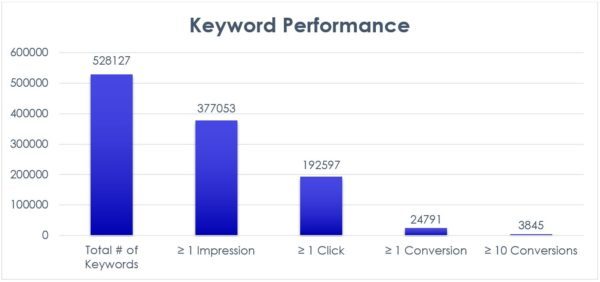
Among the converting keywords were a number of unusual cases, like a keyword which only ever got one search and one click at a $1 CPC, but that click resulted in $9,000 of sales.
Rare stories like these with 9,000x return on investment make nice anecdotes, but they’re abnormal and aren’t very useful for drawing conclusions about industry averages. So, to ensure that the results of this study would be applicable to you, we pulled the majority of our conclusions from our analysis of keywords with 10 or more conversions and ROI no greater than 150x.
Study Findings
So much for the nuts and bolts of the study. Let’s cut to the conclusions!
1. Don’t Pay Over $5 for a Click
It makes sense that the more you pay for clicks, the slimmer your returns will be. But aren’t there some keywords so valuable that they’re worth any cost?
Apparently not.
The data indicates that the most profitable keywords have relatively low cost per click (CPC). On average, keywords with a CPC of $1-25 range get an average return of 27.71x, but ROI quickly drops off at higher CPCs to the point that if you’re paying $5 or more for a click, you’re probably going to lose money even if you do get conversions.
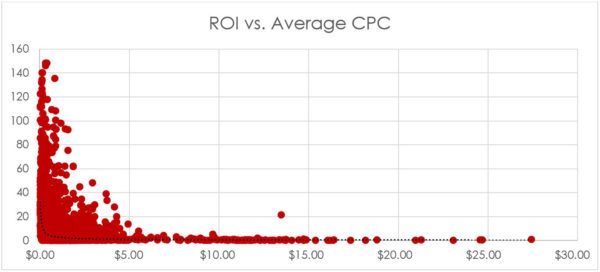
Obviously, this rule probably applies best to eCommerce companies, but even if you’re operating in an industry with a high average CPC and a high average lifetime value, the fact of the matter is, it’s hard to make money when you’re fighting a bidding war.
For example, at Disruptive, we’ve often find that we are more successful in the legal advertising space when we use broader match types. After all, it’s a lot easier to turn a profit on a keyword with a $20 CPC than a $200 CPC.
As logical as this sounds, we still see countless clients who are trying to improve their AdWords campaigns by eking out a little more performance from their most expensive keywords. As our data clearly shows, that may not be the most effective way to improve ROI.
2. Pick Mid-Length Keywords
“Ideal” keyword length is a bit of a controversial subject. Short keywords (sometimes called “head” keywords) tend to get a lot of search volume, but aren’t very specific. Very long (“long tail”) keywords have the opposite properties and medium-sized (“body”) keywords sit somewhere in between.
Marketers vary on the keyword length they recommend. Some say that body keywords are the “sweet spot,” while others feel the low competition and high specificity of long tail keywords makes them the best.
These recommendations are largely based on the clicks and conversions that keywords generate…but what keyword length actually makes the most money?
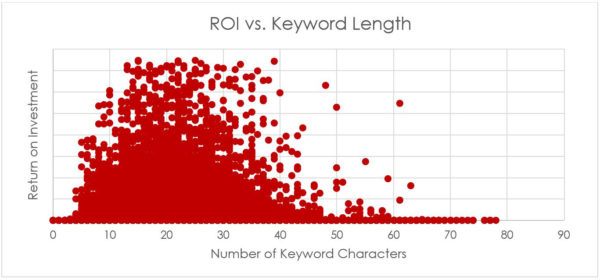
In our study, the keywords with the highest return on investment cluster between 10 and 30 characters. A good return can even come from long-tail keywords of up to about 40 characters, but keywords longer than that are probably not worth your time.
3. Clicks ≠ Conversions
Lazy conversion tracking can be easy to justify. I mean, if a keyword has a high click-through rate (CTR), then people must like it. If people like it then they must want to convert. So, CTR and conversion rate (CR) are pretty much the same thing…right?
What if I told you that clicks and conversions are actually opposites?
It sounds crazy, but our analysis actually found an inverse relationship between CTR and CR.
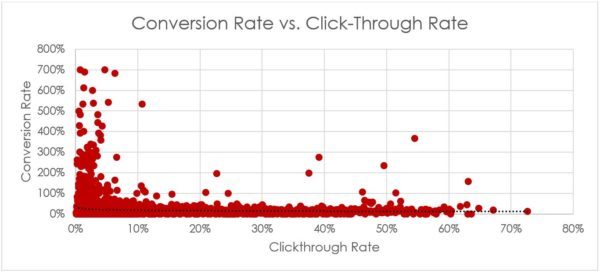
If you’re wondering why some conversion rates are over 100%, it’s because one conversion equals one sale. If a single click generates multiple sales, it will have a conversion rate greater than 100%. The percentage of clicks that produce any conversions is called click conversion rate…it’ll come up later.
Why would high click-through rate lead to low conversion rate?
There are several possible reasons, but one likely explanation is that the keywords that get the most clicks probably aren’t specific enough. They generate a lot of clicks…but from the wrong audience.
Keywords and ads that target more effectively may get less clicks but more conversions.
Moral of the story? If you’re coasting along with your basic AdWords setup, assuming that you don’t need conversion tracking because clicks are basically the same thing, then you need to think again.
4. There’s No Substitute for ROI Tracking
Like a good little reader, you probably just rushed off and added conversion tracking code to all your thank-you pages.
Excellent…good job. But is it enough?
That’s kind of the big question of this article. Are there other metrics which will predict a keyword’s profitability without directly tracking ROI?
A Statistical Aside
In order to answer this question, we need to understand a statistic called R2 (R squared). For example, take a look at this graph comparing click conversion rate (CCR) and return on investment for keywords in the $0.01-0.25 CPC range:
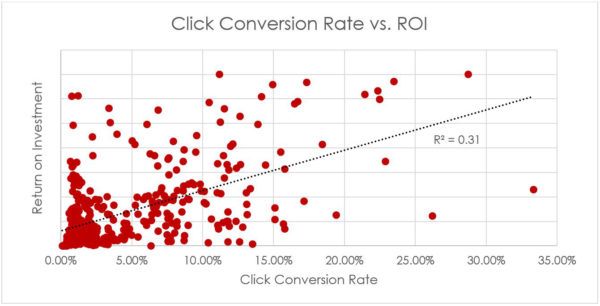
The first thing you’ll probably notice about this graph is the general trend—keywords with higher C-CR tend to get higher returns.
Second, you’ll notice the black dashed trend line running down the middle. That line is a mathematical prediction of what the trend looks like on average.
But obviously that can’t be the whole story. Very few of the data points actually line up on the trend line like perfect little averages.
So, how accurate is the trend? That’s where R2 comes in.
R2 tells you how much of one thing is predicted by something else. The R2 of 0.31 on this graph basically means that click conversion rate only predicts 31% of a keyword’s ROI.
The rest must be due to other factors, like search impression share, clickthrough rate and what the internet searchers ate for breakfast.
In essence, R2 is an approximate of how much of the story a variable tells you. If you have an R2 of 100% then you’ve got a perfect prediction and you know everything there is to know. If you’ve got a lower number then there are still factors you haven’t unaccounted for.
Putting R2 to Work
Ok, back to business! We found R2 values for lots of different metrics you can find on an AdWords report. Based on our data, the best predictors of return on investment were 1) amount of time spent on a page and 2) number of pages visited.
But this information really isn’t very helpful. People who buy a lot of stuff visit a lot of pages and spend more time on the site…duh. But it doesn’t work the other way around. Purposely designing a confusing website to keep people on your page longer won’t make them buy. In fact, it would probably do just the opposite.
So let’s throw out those two metrics and look at some of the more useful ones:

This table shows that for ecommerce businesses as a whole, the top three predictors of return on investment are 1) Click-Through Rate, 2) Cost per Click, and 3) Bounce Rate.
But how good are those predictions really?
The R2 values indicate that the correlations are pretty weak. Even the best predictor—click-through rate—only tells 27% of the ROI story.
One obvious reason for this is that we can’t lump all eCommerce businesses together and expect them to all play by the same rules. The online market for cars is completely different from the pencil market, so when we mash their data together we can expect the results to be confusing.
To clear some of this up, we divided our data into $0.25 cost-per-click categories in order to group together businesses with financial similarities. This allowed for much more accurate ROI correlations, as seen below:
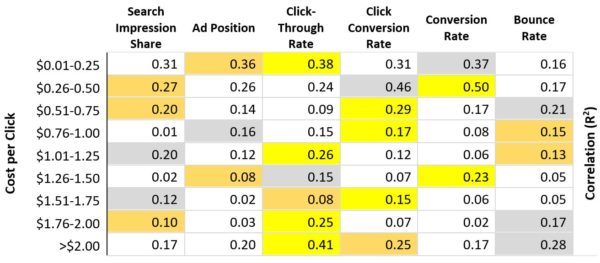
In this table, you can see which factors are the best predictors of performance in each $0.25 CPC bracket from $0.00 to $2.00. To make this chart easier to read, I’ve handed out gold, silver, and bronze medals to the top performers in each CPC subset.
Seen this way, click-through rate still seems like the overall best way to predict a keyword’s profitability, followed by click conversion rate. As the graph below illustrates, ROI is particularly hard to predict for keywords with CPC in the mid-range.
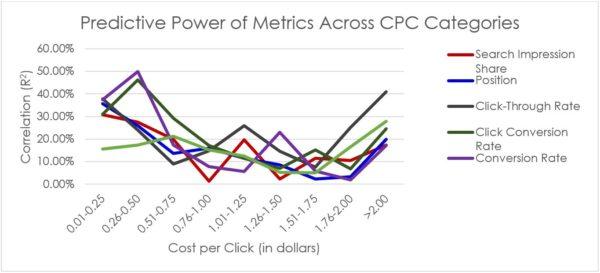
The correlations are still fairly weak, however. The best performer on the board only manages an R2 of 50%, making its prediction about as accurate as a coin toss. Even when the predictive power of multiple metrics is combined (through a technique called multiple regression), 60% accuracy was the best we could get.
What does this mean for you?
If you’re starting to get lost amidst the graphs, tables, and statistics, allow me to summarize. In short, there’s no real substitute for direct return on investment tracking for your keywords. Clicks, conversions, bounce rates and other metrics are helpful in their own ways, but none of them reliably predicts keyword profitability with any satisfactory accuracy.
If you want to know whether you’re making money, then the best solution remains the most obvious one—track your money.
The good news is that for ecommerce businesses, ROI tracking is fairly straightforward to set up. Since a conversion is the same thing as a sale (and you’re already tracking conversions…right?), all you have to do is assign a transaction value to each conversion. AdWords takes care of the rest!
But What About…!?
If you’ve gotten this far you no doubt have some questions: “But what if I don’t run an eCommerce business? Do these results still apply to me?” “Keyword performance is less important to me than ad and campaign performance. What about those?”
It’s true, this study is specific to a very small slice of the online marketing world: eCommerce keywords. Although this data matches our practical experience with clients, the specific trends could be very different for other types of online business and for other levels of ads.
That’s why this article is just part one of an ongoing series. At Disruptive Advertising we’re committed to answering these questions and delivering you the best data-driven marketing techniques available.
So hold onto your hats! More studies are coming to answer every question you’ve got!





